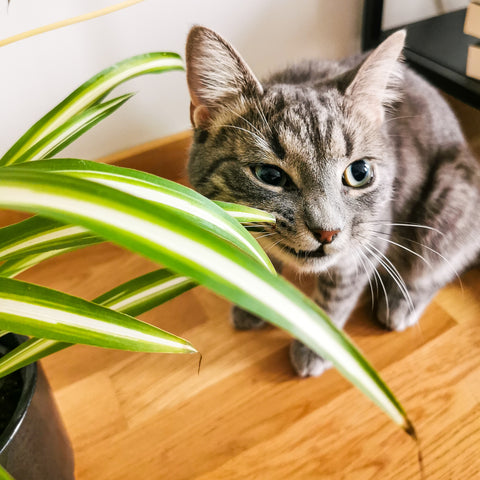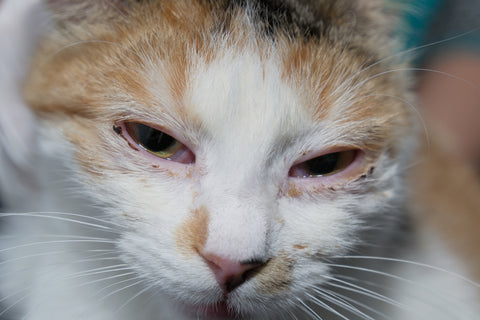
Cat obesity is an increasingly common disease and has become a top concern for pet parents and veterinarians. It is characterized by excess body fat, which accumulates to a point where a cat’s health is adversely affected. In today’s post, we’ll provide some background on cat obesity, nutrition, and actions that you can take at home and in collaboration with your veterinarian to help your cat reach and maintain a healthy weight.
Why Do Cats Get Fat?
According to the Association for Pet Obesity Prevention (APOP), an estimated 60% of cats in the U.S. are overweight or obese. Excess body fat is associated with a range of feline diseases including diabetes mellitus, gastrointestinal disease, upper and lower urinary tract conditions, osteoarthritis, chronic inflammation, and an overall decreased life span. Dr. Ernie Ward, founder of the APOP, states that cat obesity is a multifaceted condition that can be influenced by:
- Finicky eating, begging, and the role of the cat in influencing feeding behavior
- Studies reveal genetic components responsible for cats becoming overweight
- Breed as a risk factor of feline obesity
- Genetic factors associated with obesity and secondary diseases, such as diabetes mellitus
- Epigenetics and the epigenetic clock (or “cellular clock”)
- Studies on the importance of weight management following the neutering of cats
- The relationship between hormones and feline obesity
Other factors that may contribute to a cat’s propensity toward obesity include lifestyle, diet, comorbidities (e.g., diabetes, cancer), medications, and the gut microbiome.
Ideal Cat Weight Ranges
The APOP provides ideal cat weight ranges, which for domestic cats is 8-10 lbs, Persian cats 7-12 lbs, Siamese 5-10 lbs, and Maine Coons have the largest ideal weight range of between 10-25 lbs.
Your veterinarian will weigh your cat during their wellness visits; however, purchasing a digital pet scale for your home is a great way to keep track of your cat’s weight over time. It's a more accurate method for obtaining your cat’s weight than at-home scales made for human adults. Maintaining a healthy body weight for your cat is key to supporting their health, wellness, and longevity.
For details on how to weigh your cat, including tips and tricks for making the process more comfortable and stress-free, visit Certified Applied Animal Behaviorist and Certified Cat Behavior Consultant Dr. Mikel Maria Delgado’s “Weigh Your Cat!” piece found on the What Your Cat Wants blog site.
BCS For Cats
While the APOP weight ranges are good to keep in mind, these averages may not apply to all cats. Weight is not the only factor to consider—it is also important to understand your cat’s body condition score (BCS).
In the chart below, the middle image displays the ideal feline body condition. The cat represented in this image is well-proportioned, and if one were to palpate its ribs there would only be a slight covering of fat. Looking from above, the cat’s waist would be visible behind its ribs, yet not pronounced. Their abdominal “fat pad” (toward the back of their belly) would be minimal.

The build of cats can vary along with their muscle and bone density, so this is why it is important to assess not only weight, but also body condition. Body condition scoring is a process of evaluating a cat’s muscle tone (or lack thereof) and storage of fat on their body. Though there are two commonly used BCS Scales, both assess the same aspects of body composition. One is the lowest number of the scale that corresponds to a cat being too thin, and the higher number (either a 5 or a 9) on the scale corresponds to a cat that is overweight or obese. Cats with a BCS of 9 out of 9 (reflecting obesity) have a shorter average lifespan than cats in ideal weight.
Though your veterinarian will perform body condition scoring during your cat’s regular wellness visits, you can also become familiar with this process at home. To obtain a BCS for your cat, you can view and follow this step-by-step video by Hill's Pet Nutrition.
For additional details on what to look for when assessing your cat’s body condition score, review this helpful World Small Animal Veterinary Association (WSAVA) Body Condition Score illustration.
Cat Weight Loss
Collaborating with your veterinarian is a great way to help your cat reach and maintain a healthy weight goal. A supportive veterinarian will listen to your concerns and perform a wellness evaluation with a full review of your cat’s medical history. This process will also allow them to assess your cat’s weight loss needs, and help you make a plan that includes an appropriate diet and exercise regimen.
Patience is a part of the process, as healthy weight loss does not happen overnight. However, your veterinarian can help you determine the total length of time needed to achieve your cat’s target weight. Dr. Ward recommends nine to 12 months as a maximum period of time for following a weight loss program, though six to nine months can be a more optimal time frame for most cats. You would then divide the total period of time into one to three month intervals for “step” weight loss, so that you can create checkpoints to assess your cat’s progress. Ideally, after the weight loss time period, you can then continue with maintenance of the new program to keep your cat at a stable and healthy weight.
General guidelines for safe weight loss is about 0.5 pounds per month in cats (1-3% body weight). Always consult with your veterinarian before starting your cat’s weight loss program to ensure that you are taking the proper and safe steps for your cat’s health.
Cat Nutrition
“Obesity is the number one health threat pets face, and the most important pet health decision owners make each day is what and how much they feed.”
— Dr. Ernie Ward, Founder of the Association for Pet Obesity Prevention

Caloric Needs
The foundation of health is proper nutrition. Identifying and setting caloric needs based on your cat’s current and ideal weight, health conditions, and life stage is important.
Once you have your cat examined by your veterinarian and an ideal weight calculated, you can manage your cat’s caloric needs per day and track progress over one to three month intervals. Remember, all food intake should be considered within the recommended daily caloric count. This includes treats! It is easy to forget just how quickly things can add up, so be sure to communicate with other household members and adhere to a portion control plan.
Nutritional Standards and Quality
Pet food packaging should have a "Nutritional Adequacy Statement," also known as the "AAFCO statement". AAFCO stands for Association of American Feed Control Officials—the group responsible for publishing nutritional profiles for pets. The AAFCO statement will tell us:
- Whether the food meets all the nutritional requirements as determined by AAFCO.
- The lifestage (baby, adult, senior, pregnant/lactating) appropriateness of the food.
You can find more information on pet food labels and pet food industry regulation on the AAFCO website.
When it comes to cat nutrition, ingredients alone are not necessarily the determining factor of food quality. The AAFCO statement is not an assessment of product ingredient quality or manufacturing process. It is a report of whether the food contains nutrients within the minimum and maximum quantities as recommended for a healthy pet, not that it has evaluated the final product, or how it assessed the profiles. For this reason, it is essential to ensure a quality manufacturer produces the food.
As you have surely experienced, there is no shortage of choices when it comes to feline diets. Determining which is the best for your cat can be mind-boggling. Many options will have the AAFCO statement, so how do we narrow down our picks to determine food quality? Again, ingredients are not always the first thing we look to.
Before we consider the ingredients and their quality, we first want to look to the manufacturer, as this can be a significant factor in assessing the quality of the ingredients and product. Store-brand foods generally outsource and many big brand stores do not manufacture their own food. It is ideal when the manufacturer on the label owns the processing plant where the food is being produced and that they:
- Employ at least one qualified nutritionist (in animal nutrition).
- Have stringent quality control, end-product testing, and audit measures in place.
- Provide food that is subject to AAFCO feeding trials.
- Are willing to provide feeding trial assessment outcomes upon request.
Getting back to ingredients, which are still important to consider, the AFFCO also provides guidelines and resources on pet food safety and ingredient standards.
Other Actions You Can Take At-Home
In addition to nutritional planning and implementation, there are other ways that you can support your cat throughout their healthy weight loss and healthy weight management process.
Reducing Stress at Feeding Time
Every cat is unique, with equally unique feeding habits. Some special kitties may be social feeders who like having human or other furry family members present; however, most cats prefer to eat alone—away from perceived competitors for food. Stress can be a big factor that influences whether or not your cat is packing on the pounds. Observing your cat's preferences and making adjustments, such as providing separate feeding times and/or spaces, is the best way to accommodate their needs for a calm, stress-free eating experience.
Adjusting Feeding Methods
Recent research (Delgado & Dantas, 2020) has shown that how cats are fed should reflect the ways that they would naturally eat. Small, more frequent feedings throughout the day and feeding that encourages foraging behavior (e.g., food puzzles) can be very helpful for preventing and/or addressing obesity in cats.
Increasing Activity Level
Increased duration and frequency of activity and play is another important part of your cat’s healthy weight management program. Cats do most things in small, short-bursts. We want to keep this in mind when considering enrichment through play. To get started, play sessions can be short (2-5 minutes), yet occur frequently throughout the day.

As you experiment with different types of cat toys and styles of play to find what your cat enjoys, you will find out ways to increase play duration and frequency. Fishing-style toys can make great playtime additions, as they encourage jumping and chasing that are a part of a cat’s natural predatory instincts.
The APOP shares some other “creative exercise” ideas for cats with tips on how to get your cat moving and playing more regularly.
Join a Supportive Cat Parent Community
We hope that you found the topics discussed in this blog helpful! Be sure to visit the APOP website, where you can find a variety of additional information on cat weight loss and helpful weight loss tools.
We know that implementing a new weight loss routine with your cat can seem daunting, but the Basepaws community is here to help you along the way. We offer regular webinars on different topics in feline health and you can follow us on social media to learn more about these events and other exciting developments. Consider joining the Basepaws Cat Club on Facebook, a forum where you can connect with other cat parents as well as access a suite of resources on feline health.
Don’t forget to look over our ongoing citizen science research programs to get involved in helping us to improve the lives of all cats, everywhere. We even have an exciting feline longevity project with Dr. Ernie Ward that is part of our work to put cats front-and-center in pioneering genetics and pet health research. Through this study, Basepaws aims to discover the genetic predispositions of thriving, healthy senior cats who live well into their late teens and even twenties.
Basepaws Research


